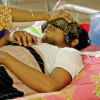Our dengue control methods are beyond inadequate

The number of dengue patients this year is increasing at an alarming rate across the country. According to the Directorate General of Health Services (DGHS), a record number of 281 people died of dengue in the country last year. This year, the number of dengue cases in the first five months (even before the onset of dengue season) is six times that of last year during the same period.
The situation has further deteriorated in June with the onset of monsoon, which is the breeding season for Aedes mosquitoes. According to the DGHS, from January 1 to June 20 last year, the number of people hospitalised with dengue was 781, with zero deaths. But this year, till June 20, 5,564 people were hospitalised and 36 died of dengue. The situation is getting worse with each passing day because the local government and health ministries are failing to take comprehensive steps to control the Aedes mosquito population.
Aedes larvae are not only found in flower tubs in people's houses or in stagnant water on roofs. They can breed in water accumulated in bottles, packets, cans, containers, barrels, abandoned tires, and brick pits in various public places, and especially inside under-construction buildings and structures.
A survey by the DGHS showed that three of the most common breeding areas for Aedes mosquitoes are discarded tires, flooded floors (basement or otherwise), and plastic drums. Flower tubs and trays accounted for only 3.87 percent of the breeding sources.
Dr BN Nagpal, the senior entomologist of the World Health Organization, said during his 2019 Dhaka visit that construction projects are one of the biggest sources of Aedes mosquitoes. By controlling mosquito breeding at construction sites, it is possible to reduce dengue by 40 percent. And it is the responsibility of relevant ministries and departments of the government, including city corporations, to ensure that Aedes mosquitoes do not breed in abandoned tires or construction projects.
It is also the responsibility of government authorities to encourage and compel concerned companies and individuals to not allow the accumulation of stagnant water inside privately-owned housing. For this, our cities can follow the steps taken by the Kolkata Municipal Corporation. Instead of starting its mosquito-controlling activities in monsoon, the Kolkata city authority works round the year to control the population of Aedes mosquitoes. The corporation keeps an eye on accumulation of stagnant water throughout the year and closely follows hospital records to see whether people are being diagnosed with dengue, so that they can take prompt measures. Some 15-20 people, divided into two groups, work in each of the 144 wards of Kolkata city. One group conducts awareness campaigns on the disease, while the other looks for the presence of stagnant water in their assigned areas. Rapid action teams, comprising 8-10 members, are also kept on stand-by in each of the 16 boroughs. When a dengue outbreak is reported anywhere, they quickly move to destroy breeding grounds of Aedes mosquitos.
Singapore is also a great example of what state institutional initiatives should look like in terms of dengue control. Staff from the National Environment Agency (NEA) in Singapore regularly set out to destroy Aedes larvae breeding grounds in public spaces, construction sites, and housing estates. Special attention is paid to potentially hazardous areas such as construction sites during inspection activities. The Code of Practice of Environmental Control Officers (ECO) in Singapore, as part of vector control, requires contractors to employ pest control agencies and cleaners, whose job is to clean the floors every morning and apply anti-mosquito oil once a week to prevent larvae from breeding in stagnant water on these sites, and to also kill them by cutting off air circulation. The NEA checks construction sites once a month; and violations can result in penalties as severe as an order to stop construction.
An important method of dengue prevention is to identify dengue-infested areas separately as "dengue clusters," locate and destroy the source of Aedes larvae, and educate the local population.
In Singapore, during a period of 14 days, if two or more dengue cases are found in a 150-metre area in any residential block, the whole block is declared a dengue cluster, and a red or yellow banner, depending on the number of patients, is pulled up to alert residents. Moreover, the NEA website has updated information on dengue clusters for citizens' awareness. The NEA has set up around 70,000 Gravitraps across Singapore to trap female Aedes mosquitoes that want to lay eggs. From the data on the mosquitoes caught in its traps, the NEA can estimate the prevalence of Aedes mosquitoes in some areas, so that the most effective results can be obtained by conducting operations in those specific areas. Moreover, these traps can kill a large number of adult Aedes mosquitoes, too.
Unfortunately, in the case of Bangladesh, dengue prevention activities are not carried out round the year. The health ministry attempts to fulfil its responsibility only by giving advance warning, and neither the city corporations nor the local government ministry take any effective measures to control the population of Aedes mosquitoes and larvae – even after receiving advance warning.
Dengue does not spread everywhere at once; its prevalence tends to be higher in some areas. For example, according to news reports, almost half of the dengue patients under treatment at the capital's Mugda Medical College Hospital are residents of different areas of Jatrabari.
If proper measures are taken to control dengue in such clusters on time, the disease will not spread easily across entire cities or the whole country. Besides working round the year to control Aedes mosquito population (and not just with the beginning of monsoon), it is important for our public authorities to identify dengue clusters by analysing the addresses of patients and take truly effective measures to control the population and migration of Aedes mosquitoes before the dengue situation worsens further each passing year.
Kallol Mustafa is an engineer and writer who focuses on power, energy, environment and development economics.

 For all latest news, follow The Daily Star's Google News channel.
For all latest news, follow The Daily Star's Google News channel. 













Comments